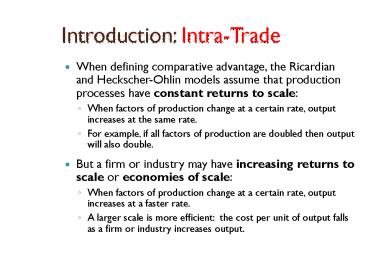Introduction: IntraTrade PowerPoint PPT Presentation
1 / 12
Title: Introduction: IntraTrade
1
Introduction Intra-Trade
- When defining comparative advantage, the
Ricardian and Heckscher-Ohlin models assume that
production processes have constant returns to
scale - When factors of production change at a certain
rate, output increases at the same rate. - For example, if all factors of production are
doubled then output will also double. - But a firm or industry may have increasing
returns to scale or economies of scale - When factors of production change at a certain
rate, output increases at a faster rate. - A larger scale is more efficient the cost per
unit of output falls as a firm or industry
increases output.
2
Introduction (cont.)
- The Ricardian and Heckscher-Ohlin models also
rely on competition to predict that all income
from production is paid to owners of factors of
production no excess or monopoly profits
exist. - But when economies of scale exist, large firms
may be more efficient than small firms, and the
industry may consist of a monopoly or a few large
firms. - Production may be imperfectly competitive in the
sense that excess or monopoly profits are
captured by large firms.
3
Types of Economies of Scale
- Economies of scale could mean either that larger
firms or a larger industry is more efficient. - External economies of scale occur when cost per
unit of output depends on the size of the
industry. - Internal economies of scale occur when the cost
per unit of output depends on the size of a firm.
4
Inter-industry Trade
- According to the Heckscher-Ohlin model or
Ricardian model, countries are exporters of one
good and importers of the other. - Trade occurs only between industries
inter-industry trade - In a Heckscher-Ohlin model suppose that
- The capital abundant domestic economy specializes
in the production of capital intensive cloth,
which is imported by the foreign economy. - The labor abundant foreign economy specializes in
the production of labor intensive food, which is
imported by the domestic economy.
5
Trade in a World Without Increasing Returns
6
Intra-industry Trade
- Suppose now that the global cloth industry is
described by the monopolistic competition model. - Because of product differentiation, suppose that
each country produces different types of cloth. - Because of economies of scale, large markets are
desirable the foreign country exports some cloth
and the domestic country exports some cloth. - Trade occurs within the cloth industry
intra-industry trade
7
Intra-industry Trade (cont.)
- If domestic country is capital abundant, it still
has a comparative advantage in cloth. - It should therefore export more cloth than it
imports. - Suppose that the trade in the food industry
continues to be determined by comparative
advantage.
8
Trade with Increasing Returns and Monopolistic
Competition
9
Inter-industry and Intra-industry Trade
- Gains from inter-industry trade reflect
comparative advantage. - Gains from intra-industry trade reflect economies
of scale (lower costs) and wider consumer
choices. - The monopolistic competition model does not
predict in which country firms locate, but a
comparative advantage in producing the
differentiated good will likely cause a country
to export more of that good than it imports.
10
Inter-industry and Intra-industry Trade (cont.)
- The relative importance of intra-industry trade
depends on how similar countries are. - Countries with similar relative amounts of
factors of production are predicted to have
intra-industry trade. - Countries with different relative amounts of
factors of production are predicted to have
inter-industry trade. - Unlike inter-industry trade in the
Heckscher-Ohlin model, income distribution
effects are not predicted to occur with
intra-industry trade.
11
Inter-industry and Intra-industry Trade (cont.)
- About 25 of world trade is intra-industry trade
according to standard industrial classifications. - But some industries have more intra-industry
trade than others those industries requiring
relatively large amounts of skilled labor,
technology, and physical capital exhibit
intra-industry trade for the U.S. - Countries with similar relative amounts of
skilled labor, technology, and physical capital
engage in a large amount of intra-industry trade
with the U.S.
12
Indexes of Intra-industry Trade for U.S.
Industries, 1993
Note an index of 1 means that all trade is
intra-industry trade. An index of 0 means that
all trade is inter-industry trade.

